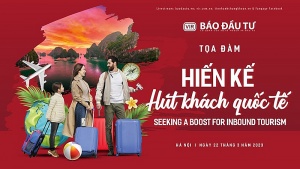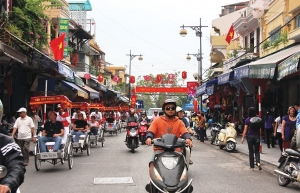Ambitious action plan needed to lure international tourists
The tourism sector is projected to earn $130-135 billion and create 8.5 million jobs by 2030, contributing 15-17 per cent of GDP and create 8.5 million jobs. Vietnam looks to attract at least 50 million foreigners and serve 160 million domestic tourists by that time
In early 2020, the prime minister approved the national tourism development strategy to 2030, with ambitious goals. By 2030, Vietnam sets a target to make tourism a spearhead and sustainable economic sector and become one of 30 countries with the best tourism competitiveness.
However, after the issuance of the new plan, the tourism industry was hit by the impact of the pandemic. After two years of pandemic, on March 15, 2022, Vietnam restored socioeconomic activities. Although Vietnam was the first country to reopen after the pandemic, we have not taken advantage of it. While Thailand, Indonesia, and Singapore exceeded the target of international tourists, Vietnam only received about 3.5 million international visitors, far from the target of five million.
 |
| Doan Van Binh, vice president of the Vietnam Real Estate Association (VNREA) |
Tourism experts and economists believe that visa barriers should be resolved soon so that tourism can become the spearhead economic sector. When Vietnam opened the border to international visitors, the country only exempted visas for 24 countries, with a visa validity of 15 days instead of 30 days as before. This policy has remained almost unchanged.
In terms of national openness, all countries in ASEAN have more open visa policies. For example, Thailand exempts visa for 65 countries with visa durations of 30, 45, or 90 days. Thailand has just issued a policy to attract the rich and digital nomads, with a visa period of 5–10 years. EU countries issue Schengen visas according to the travel needs of visitors, usually 90 days, and allow multiple entry and exit.
Except for the United Kingdom, other European countries exempt the visa if visitors already have a Schengen visa. The US grants a one-year visa and has an annual renewal mechanism. Canada grants a visa for up to 10 years, depending on the validity of the visitor's passport. Most Central American, Latin American, and Caribbean countries are visa-free if visitors have a visa to the United States.
Vietnam needs a drastic action plan to boost the attraction of international tourists.
Firstly, it is necessary to change the mindset. Tourism is an integrated economic sector with the participation of both the public and private sectors, the state, businesses, and people. Without one of these links, strategic goals will not be achieved, much like the bureaucratic process of applying for a visa.
Every citizen and business must be a tourism ambassador. It is simply unacceptable that we organise travel fairs around the world to attract tourists to Vietnam but present many difficulties for them in terms of visas, airports, taxis, hotel rooms, the attitude of civil servants, littering, and street thefts.
Second, a competent agency is needed to coordinate the tourism industry. Many countries have tourism ministries. We have the National Administration of Tourism (soon to become the Department of Tourism) under the Ministry of Culture, Sports, and Tourism. However, tourism is a general economic industry. A tourism project can use up to 2,500 products and services, which have spillover effects on 40 other industries in the economy. Tourism involves many state agencies and many branches and fields, so it is necessary to give more authority to the National Administration of Tourism or create a higher-level agency with greater authority for overall coordination.
Third, there should be a clear assignment of responsibilities among the public and private sector to implement the tourism strategy. It is also vital to clarify what the state does and what the private sector does to optimize national resources.
Fourth, the country should be more flexible about visa policies. Eventually, visa exemption is required for most countries. In the immediate future, it is necessary to expand visa exemption for key market countries and apply e-visas and on-arrival visas for the remaining countries.
Vietnam should allow entry for tourism purposes if visitors have been allowed to enter countries that are visa-free for Vietnam. We should consider the intra-ASEAN coordination mechanism based on economic and security cooperation pillars to exploit the common tourism market.
Specifically, if visitors secure visas for one country, they can enter other countries within the bloc. Another suggestion is to extend the visa exemption and visa period to 90 days, according to international practice. We should consider building a long-term visa policy of 5–10 years for some specific groups of visitors, such as investment groups buying a second-home or digital nomads.
 |
Fifth, Vietnam needs to build a completely new image. It is necessary to build an entirely new marketing and communication strategy, from slogans to videos and images of the country, people, history, culture, nature, and cuisine. One problem is that each locality does marketing and communication separately, failing to make efficient use of resources. We should also find out the core communication points for the whole market, targeting tourism, trade, services, exports, and investment.
Sixth, we should maintain and expand key markets. The Americas should not be considered a key tourist market because of the long distance to Vietnam. Meanwhile, they have many competitive options right within the Americas. In terms of nature, America has the Caribbean, which is one of the global marine tourism centres. There are also many beautiful coastal cities such as Miami, Hawaii (the US), Cancun (Mexico), Rio De Janeiro (Brazil), Varadero (Cuba), and the Amazon Forest. World heritage, cultural festivals, and cuisine are also rich. Visitors can go wintering down to South America and Hawaii, the sunny tropical state with the beautiful beach of Waikiki. Therefore, the number of visitors from the Americas to Asia, including Vietnam, is not much. Vietnam needs to focus on maintaining the traditional key markets of Northeast Asia, Europe, Russia, Australia, New Zealand, intra-ASEAN, and expanding to India and Arab countries.
Last but not least, it is necessary to for Vietnam to build a night economy with corresponding policies to attract tourists to come, stay longer, spend more money, and, most importantly, meet their needs.
For example, Europe and Vietnam have a 5–6 hour difference in time zone. If we don't have a night economy, what will tourists do? They come to travel, not to sleep. Paris, London, Amsterdam, Ibiza, Rio de Janeiro, Tokyo, Seoul, Hong Kong, Bangkok, and Singapore are centres that attract tourists for the night economy globally from which Vietnam can learn.
 | VIR to host a roundtable on boosting tourism VIR will hold a roundtable discussion themed "Seeking a boost for inbound tourism" with the participation of both local and foreign experts, who will discuss both the situation and solutions to make Vietnam more attractive to international tourists. |
 | Upbeat prediction for Vietnamese tourism Following a record year of expansion in Vietnam, Jakob Helgen, Marriott International area vice president for Thailand, Vietnam, Cambodia and Myanmar, discussed Vietnamese tourism in 2023. |
 | Tactics bulked up to meet tourism targets With a target of $28.3 billion in revenue, contributing 5 per cent of the country’s GDP, Vietnam’s tourism sector needs a clear strategy if it is to have a successful 2023. |
What the stars mean:
★ Poor ★ ★ Promising ★★★ Good ★★★★ Very good ★★★★★ Exceptional
Related Contents
Latest News
More News
- Vietjet launches daily Manila flights to celebrate year-end festive peak season (December 05, 2025 | 13:47)
- Phu Tho emerges as northern Vietnam’s new tourism hub (December 01, 2025 | 17:00)
- Vietjet completes Airbus A320/A321 updates ahead of deadline (December 01, 2025 | 09:49)
- Vietjet resumes Con Dao flights from early December (November 28, 2025 | 15:24)
- Free tickets, Lunar New Year promotions on offer at Vietjet Mega Livestream (November 26, 2025 | 15:32)
- UNIQLO unveils upgraded heat-retention wear at Hanoi event (October 26, 2025 | 10:00)
- Vietnam named among world’s top four culinary destinations (October 24, 2025 | 17:09)
- Vietnam and Denmark strengthen dialogue on sustainable fashion (October 20, 2025 | 09:11)
- Fusion rolls out special initiatives to celebrate Vietnamese Women’s Day (October 17, 2025 | 20:00)
- Showcase AC 2025 set to light up Hanoi stage (September 12, 2025 | 18:06)

 Tag:
Tag:





















 Mobile Version
Mobile Version